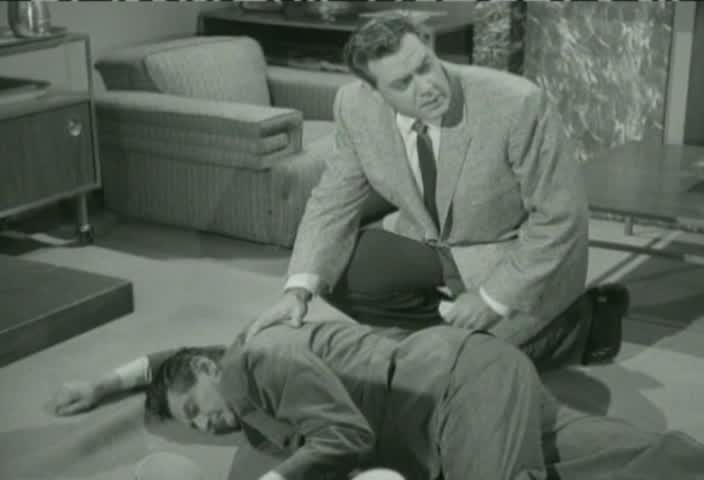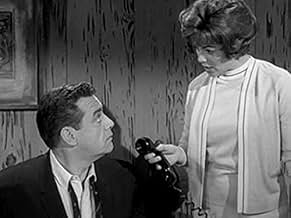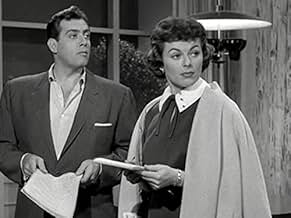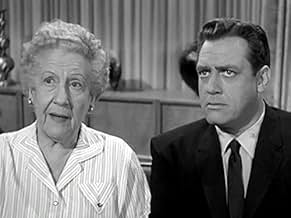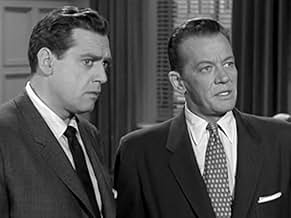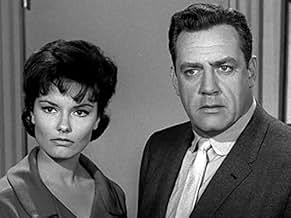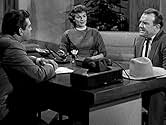Les affaires d'un avocat principal de la défense pénale, traitant la plus difficile des affaires pour aider des innocents.Les affaires d'un avocat principal de la défense pénale, traitant la plus difficile des affaires pour aider des innocents.Les affaires d'un avocat principal de la défense pénale, traitant la plus difficile des affaires pour aider des innocents.
- Récompensé par 3 Primetime Emmys
- 7 victoires et 7 nominations au total
Parcourir les épisodes
Avis à la une
Perry Mason is one of the finest shows (courtroom or otherwise) that was ever made. A memorable cast, great scripts, and always a surprise in the courtroom. I watched the shows for years and years in re-runs. Being blessed with a poor memory, I could usually be depended on to forget the final outcome of the trials. There were quite a few shows and guest starts to keep track of. One "highlight" of my life was to get onto a murder trial jury myself during some of my more intense Perry Mason years.
The thing that separated 'Perry' from other shows was it's compactness. It was all story. Personal relationships were hinted at, but took up little time on the screen. If some errand needed to be run, Paul Drake (the detective) would appear with the information in the next scene. Nor car chases, no fistfights, and no love interest in every episode. JUST STORY. I've heard this is one reason Raymond Burr gave up the show. The show was so dependant on him in just about every scene that he had to live on the studio lot in a trailer during filming (and that was most of the year).
In contrast, later 'Perry Mason' attempts HAD the aforementioned elements. There were car chases, fist fights, and Paul Drake Jr. was allowed much screen time for these and to win over the girl too. We got to see all the painstaking effort to get the information his dad just seemed to pull out of the air.
It was good to see Perry back, and I did watch. The 'newer' shows paled by comparison to the all-time classic original. But, it's tough for anything to live up to our memories.....
PS- I even sang along to the very recognize-able theme with lyrics of my own.......
The thing that separated 'Perry' from other shows was it's compactness. It was all story. Personal relationships were hinted at, but took up little time on the screen. If some errand needed to be run, Paul Drake (the detective) would appear with the information in the next scene. Nor car chases, no fistfights, and no love interest in every episode. JUST STORY. I've heard this is one reason Raymond Burr gave up the show. The show was so dependant on him in just about every scene that he had to live on the studio lot in a trailer during filming (and that was most of the year).
In contrast, later 'Perry Mason' attempts HAD the aforementioned elements. There were car chases, fist fights, and Paul Drake Jr. was allowed much screen time for these and to win over the girl too. We got to see all the painstaking effort to get the information his dad just seemed to pull out of the air.
It was good to see Perry back, and I did watch. The 'newer' shows paled by comparison to the all-time classic original. But, it's tough for anything to live up to our memories.....
PS- I even sang along to the very recognize-able theme with lyrics of my own.......
Without a doubt,the series "Perry Mason" was the granddaddy of all lawyer shows and even after 40 years since its debut it is still highly watchably and still highly rated as one of the top courtroom drama shows of all time. Raymond Burr was a true genius as the lawyer who would go to any length to protect his cilents from a certain fate and he always had a detective sense to find out who was the killer or who was trying to blackmail someone. Perry Mason was part lawyer/part detective/part sleuth. The show was based on the books about the character by Earl Stanley Gardner and for the astounding nine seasons that it ran on CBS-TV (1957-1966),it still holds up today. Even some college law professors used some of the episodes as teaching material as a learning technique for up and coming lawyers.
As for the rest of the show,the formula was very simple:(1)The first half of the show tells the story of the events leading up to the murder and the preliminary investigation of the crime and the facts leading up to the case in question and clues of where and what may have occurred. (2)The second half dealt with the subsequent trial,where Mason exposes the truth in the courtroom.
Sometimes the plots were very complex at times,but mostly were written with style and class and it is the only show where the writers treated the viewer with intelligence. The actors were very good especially within certain scenes where Mason has a battle of wits with District Attorney Burger. However it was done with style and had stunning black and white photography to make it more interesting. However,out of all the episodes their was one episode that was shown in color(and it hasn't been seen since TBS shown it during the 90's) where brought out more of the characters and more of the courtroom setting as well. As far as the show is concern,it is a milestone in the history of television. Catch some of the episodes on the Hallmark channel.
As for the rest of the show,the formula was very simple:(1)The first half of the show tells the story of the events leading up to the murder and the preliminary investigation of the crime and the facts leading up to the case in question and clues of where and what may have occurred. (2)The second half dealt with the subsequent trial,where Mason exposes the truth in the courtroom.
Sometimes the plots were very complex at times,but mostly were written with style and class and it is the only show where the writers treated the viewer with intelligence. The actors were very good especially within certain scenes where Mason has a battle of wits with District Attorney Burger. However it was done with style and had stunning black and white photography to make it more interesting. However,out of all the episodes their was one episode that was shown in color(and it hasn't been seen since TBS shown it during the 90's) where brought out more of the characters and more of the courtroom setting as well. As far as the show is concern,it is a milestone in the history of television. Catch some of the episodes on the Hallmark channel.
Everything about this series was perfect, from the acting, to the scripts, to the directing, and even to the fact that black and white was used even after the advent of color. Of course, Raymond Burr WAS Perry Mason, just about the world's greatest defense attorney, who stops at NOTHING in his search for the truth. The supporting cast was also excellent, and the guest stars, unlike in so many other series, were always of a high calibre. Some might say that the scripts were a bit formulaic, but within the basic format, over the 10 year run of the series there was infinite variety in the details of each show, with enough unexpected plot twists to constantly keep any audience guessing. The atmosphere was perfect: black and white lent a mysterious, almost gothic feeling to the episodes, which at the same time was beautifully contrasted with Perry Mason's ice cold reasoning and razor sharp sense of right and wrong. There are so many other things I could say about this series; perhaps it is best left at saying that this is the one, the only court drama, probably the best TV drama in general, and definitely one of the ten greatest series of all time.
Perhaps the most successful formula show in the history of TV. An interesting question is why, since the lead characters never varied, the outcome was predictable, and the plots could at times defy expert analysis. To me, that sounds pretty boring. So why did I faithfully watch the first runs and still catch the reruns when I can, and why did the series catch the fancy of so many others as it still does. Here are some conjectures.
Mason, Street, and Drake are more than a team-- they are a family. The chemistry among them is so good it's almost spooky. Burr's Mason is nothing if not masterful both inside the courtroom and out. He's a strong father-figure, while Hale's Della Street is the perfect secretary, sweet, attractive and highly efficient. Not quite a mother-figure (after all, this is a chaste family), she's the perfect older sister. And Hopper's Paul Drake is clever, charming, and slightly rakish. All in all, he's the perfect younger brother. Though each is a professional, together they operate as a loyal family unit. And when their final scene rolls around (The Final Fadeout, 1966), we're happy to know they will remain together even though we (the viewers) won't be with them.
The key here is Burr's grasp of character. After all, Mason wins week after week-- he never misses. What's more, he shows up the guardians of law and order week after week. If not done right, Mason would be an easy character to dislike. But Burr's Mason is never smug, never immodest, and always low-key, so we don't resent his near god-like status. This is a real tribute to Burr and the show's producers, who managed to walk a very fine line. There's one other character point worth noting. Mason's personality is the only one of the five (Burger and Tragg included) to alter. In the early episodes, he smokes, wears loud jackets, and occasionally flirts. But with the show's success, he's transformed into a paragon of virtue, probably because his character has come to stand for the quality of criminal justice in America. Shrewdly, the producers would take no chances with their golden egg.
The engaging quality of the stories varies little, an unusual feature for any formula show. That's likely because the script-writers worked with variations on six or seven basic plots. After all, they had to come up with thirty-plus mysteries every year for nine years. And each episode had to have a plausible list of suspects with a story line to unravel, which is a pretty heavy load. Then too, each entry had to have a larger than average cast of capable actors as suspects. Watching the re-runs, we see just about every familiar face from that era (one of the joys of catching the re-runs). Executive producer Gail Patrick Jackson deserves a lot of behind-the-scenes credit, since I'm sure this was not an easy series to put together week after week.
I had never thought of the show as film noir. But other reviewers have correctly pointed this out. Indeed, there are elements of noir in many of the first half hours, where the mystery sets up. Many of these were done in shadow, with strong emotions and a heavy atmosphere of doom, which distinguishes the series. For, overall, there was very little noir from any series during that sunny era. Frankly, it's that part I always enjoyed more than the courtroom scenes with their high-key lighting and extended dialogue. The general excellence of these first half- hours is another reason, I think, for the show's unusual success.
The mystery angle remains an attraction for many. It's fun, for those who want, to try to figure out the culprit. We know he or she will be exposed and the loose ends tied-up by hour's end. But the entries can be enjoyed for their drama alone. The witness-stand confessions served as a chance for neglected feature players to show their acting chops. Some of these were truly memorable. My favorite is from that great unsung actress of the era, Constance Ford. Watch her split personality emerge under Mason's perceptive grilling (The Case of the Deadly Double, 1958). It's a dramatic tour-de-force, as good as anything from the movies of the time. Many of the confessions were also poignant. The culprit could be seen as a sympathetic character, driven to murder by larger forces. And though, the epilogue (usually in Mason's office) often ended on a humorously upbeat note, the confessions remain the dramatic high point.
These are some of my best guesses. I expect there's another, not so flattering reason. Many of us, of course, have a nostalgic attachment to those younger years, which, I suppose, is only natural. Nonetheless, there is something timeless about the brave knight rescuing unfortunates in distress (in this case, usually a shapely blonde or brunette). In fact, the Mason show was predicated on that venerable premise. And even though Mason-as-ideal-defense-attorney would probably not work in today's post-Vietnam era, the key plot elements endure ( understandably, the series ended, just as the war in south-east Asia heated up). Greed, jealousy, ambition-- this is the stuff of high drama, while the Mason show used them effectively inside a format that fit its time. But the elements themselves remain timeless. And in that sense, so does the series.
Mason, Street, and Drake are more than a team-- they are a family. The chemistry among them is so good it's almost spooky. Burr's Mason is nothing if not masterful both inside the courtroom and out. He's a strong father-figure, while Hale's Della Street is the perfect secretary, sweet, attractive and highly efficient. Not quite a mother-figure (after all, this is a chaste family), she's the perfect older sister. And Hopper's Paul Drake is clever, charming, and slightly rakish. All in all, he's the perfect younger brother. Though each is a professional, together they operate as a loyal family unit. And when their final scene rolls around (The Final Fadeout, 1966), we're happy to know they will remain together even though we (the viewers) won't be with them.
The key here is Burr's grasp of character. After all, Mason wins week after week-- he never misses. What's more, he shows up the guardians of law and order week after week. If not done right, Mason would be an easy character to dislike. But Burr's Mason is never smug, never immodest, and always low-key, so we don't resent his near god-like status. This is a real tribute to Burr and the show's producers, who managed to walk a very fine line. There's one other character point worth noting. Mason's personality is the only one of the five (Burger and Tragg included) to alter. In the early episodes, he smokes, wears loud jackets, and occasionally flirts. But with the show's success, he's transformed into a paragon of virtue, probably because his character has come to stand for the quality of criminal justice in America. Shrewdly, the producers would take no chances with their golden egg.
The engaging quality of the stories varies little, an unusual feature for any formula show. That's likely because the script-writers worked with variations on six or seven basic plots. After all, they had to come up with thirty-plus mysteries every year for nine years. And each episode had to have a plausible list of suspects with a story line to unravel, which is a pretty heavy load. Then too, each entry had to have a larger than average cast of capable actors as suspects. Watching the re-runs, we see just about every familiar face from that era (one of the joys of catching the re-runs). Executive producer Gail Patrick Jackson deserves a lot of behind-the-scenes credit, since I'm sure this was not an easy series to put together week after week.
I had never thought of the show as film noir. But other reviewers have correctly pointed this out. Indeed, there are elements of noir in many of the first half hours, where the mystery sets up. Many of these were done in shadow, with strong emotions and a heavy atmosphere of doom, which distinguishes the series. For, overall, there was very little noir from any series during that sunny era. Frankly, it's that part I always enjoyed more than the courtroom scenes with their high-key lighting and extended dialogue. The general excellence of these first half- hours is another reason, I think, for the show's unusual success.
The mystery angle remains an attraction for many. It's fun, for those who want, to try to figure out the culprit. We know he or she will be exposed and the loose ends tied-up by hour's end. But the entries can be enjoyed for their drama alone. The witness-stand confessions served as a chance for neglected feature players to show their acting chops. Some of these were truly memorable. My favorite is from that great unsung actress of the era, Constance Ford. Watch her split personality emerge under Mason's perceptive grilling (The Case of the Deadly Double, 1958). It's a dramatic tour-de-force, as good as anything from the movies of the time. Many of the confessions were also poignant. The culprit could be seen as a sympathetic character, driven to murder by larger forces. And though, the epilogue (usually in Mason's office) often ended on a humorously upbeat note, the confessions remain the dramatic high point.
These are some of my best guesses. I expect there's another, not so flattering reason. Many of us, of course, have a nostalgic attachment to those younger years, which, I suppose, is only natural. Nonetheless, there is something timeless about the brave knight rescuing unfortunates in distress (in this case, usually a shapely blonde or brunette). In fact, the Mason show was predicated on that venerable premise. And even though Mason-as-ideal-defense-attorney would probably not work in today's post-Vietnam era, the key plot elements endure ( understandably, the series ended, just as the war in south-east Asia heated up). Greed, jealousy, ambition-- this is the stuff of high drama, while the Mason show used them effectively inside a format that fit its time. But the elements themselves remain timeless. And in that sense, so does the series.
10twanurit
One can tell the timeless longevity of a television series by the condition if it's still playing on TV. "Perry Mason" (1957-1966) is! It followed a tried-and-true formula: the first half-hour the situation is developed, then there's a murder. The second half-hour is filled with courtroom dramatics, to find the killer. But this is considerably heightened by a moody musical score, shadowy, gripping B&W photography, incisive scripts, magnificent guest stars (many who appeared multiple times), and lastly the brilliant ensemble cast headed by Raymond Burr, with Barbara Hale, William Hopper, William Talman and others. The series was re-done (poorly) in 1973, the more recent 2 hour TV movies were padded and don't hold up to repeated viewings. Voted the top dramatic series by TV Guide, it just does not get any better. Case closed.
Le saviez-vous
- AnecdotesWhen Raymond Burr missed several episodes due to illness, he was replaced by several guest attorneys who were played by Bette Davis, Walter Pidgeon, Hugh O'Brian, Michael Rennie, and Mike Connors.
- GaffesPerry Mason's office is given as on the 9th floor of the fictional "Brent Building" in Los Angeles, and has a distinctive terrace outside (as does the next-door office in S.8 Ep. 30). However, establishing shots of the exterior use a photo of a plain-sided office building with no balconies or terraces on the 9th floor, or anywhere else.
- Citations
Hamilton Burger: Incompetent, irrelevant, and immaterial!
- ConnexionsFeatured in Guêpier pour trois abeilles (1967)
Meilleurs choix
Connectez-vous pour évaluer et suivre la liste de favoris afin de recevoir des recommandations personnalisées
Détails
- Date de sortie
- Pays d’origine
- Langue
- Aussi connu sous le nom de
- Перрі Мейсон
- Lieux de tournage
- Sociétés de production
- Voir plus de crédits d'entreprise sur IMDbPro
- Durée1 heure
- Couleur
- Mixage
- Rapport de forme
- 1.33 : 1
Contribuer à cette page
Suggérer une modification ou ajouter du contenu manquant

